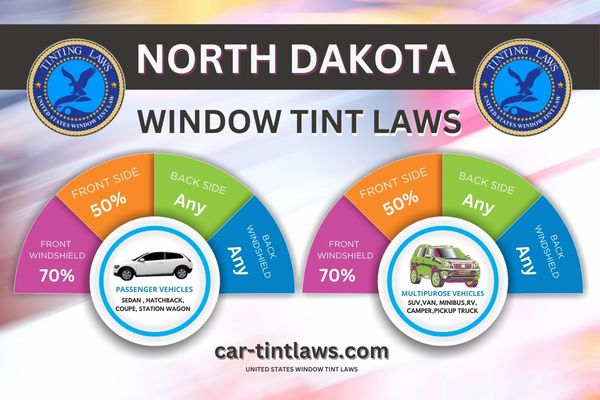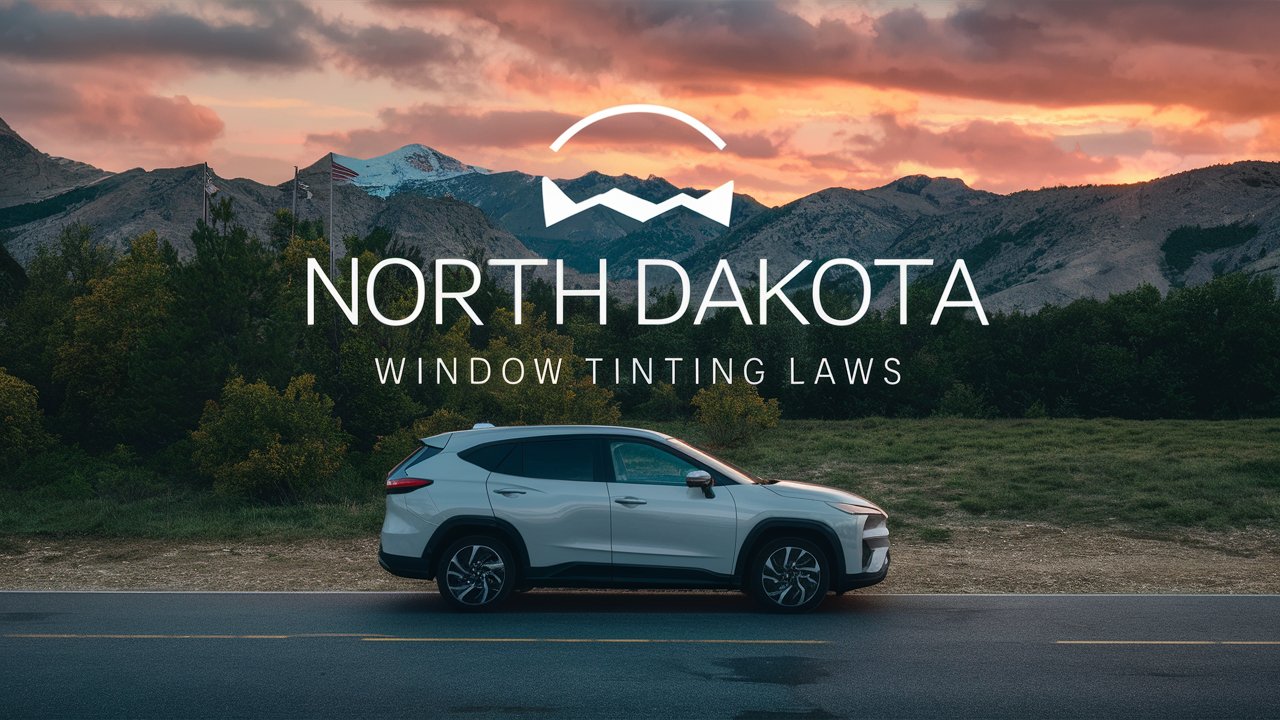When it comes to window tinting in North Dakota, it’s like deciphering a modern-day Code of Hammurabi.
You might think tinting your car windows is a straightforward decision, but understanding the specific legal requirements can be a bit of a labyrinth.
For instance, sedans must allow more than 50% of light through their front and back side windows, while SUVs and vans have more lenient rules for the back.
And don’t forget, there’s also the matter of reflectivity to assess. Wondering how these regulations could impact you and your vehicle? Let’s explore further.
Window Tint Darkness in North Dakota
When considering tint darkness for sedans in North Dakota, you’re required to make sure that front side windows allow more than 50% of light to pass through, while back side windows and rear windows have no specific tint limits.
For SUVs and vans, the same rules apply regarding the front side windows, but again, there are no restrictions on the tint darkness for the back side and rear windows.
It’s important to remember that these regulations are measured using the visible light transmission percentage (VLT%).
Tint darkness for sedans:
- Windshield: Must allow more than 70% of light in.
- Front Side windows: Must allow more than 50% of light in.
- Back Side windows: Any darkness can be used.
- Rear Window: Any darkness can be used.
Tint darkness for SUV and Vans:
SUV and Vans Tint Darkness Regulations in North Dakota:
- Windshield: Must allow more than 70% of light in.
- Front Side windows: Must allow more than 50% of light in.
- Back Side windows: Any darkness can be used.
- Rear window: Any darkness can be used.
SUV and van owners in North Dakota must adhere to these specific VLT percentages for their window tint to ensure legal compliance and maintain visibility standards.
Metallic or mirrored tints are not allowed as they can hinder visibility and pose safety risks.
By following these guidelines, you’ll help create safer driving conditions and avoid potential penalties.
Stay informed and ensure your vehicle is legally tinted for a secure driving experience.
Window Tint Reflection in North Dakota
When considering window tint reflection in North Dakota, you’ll find that both sedans and SUVs or vans must adhere to strict guidelines.
Specifically, front side and back side windows on these vehicles cannot have a metallic or mirrored appearance.
This regulation aims to guarantee clear visibility and safety for all drivers on the road.
Tint reflection for sedans:
- Front Side windows: Must not be more than 20% reflective.
- Back Side windows: Must not be more than 20% reflective.
Tint reflection for SUV and vans:
- Front Side windows: Must not have a metallic or mirrored appearance.
- Back Side windows: Must not have a metallic or mirrored appearance.
Other North Dakota window tint rules and regulations
- Side Mirrors: No restrictions.
- Restricted Colors: In North Dakota, all tint colors are permitted.
- Certificates: Manufacturers of film need to certify the film they sell in the state. Ask your dealer if they are using certified film.
- Stickers: The sticker/label of compliance to identify legal tinting is not required in North Dakota.
- Medical Exceptions: North Dakota does not permit medical exemptions for special tint.
- Penalties: Violating window tint regulations in North Dakota could result in fines.

Medical Exemptions for Window Tint Rules in North Dakota
Despite what you might hope, North Dakota doesn’t offer any medical exemptions for its window tinting laws.
This means that, regardless of any medical conditions, you’ll need to comply with the standard tinting regulations set by the state.
According to North Dakota laws, all vehicles must adhere to strict light transmittance percentages for tinted windows, maintaining uniformity for all drivers.
Medical exemptions for window tint are not recognized in North Dakota, which means even if you have a condition that might benefit from darker windows, you won’t be able to tint beyond the legal limit.
These tinting rules apply uniformly, with no allowances made for medical reasons.
The state’s regulations specify the maximum allowable darkness of window tint, and all cars must follow these limits.
This policy aims to maintain road safety and visibility standards, without exceptions.
So, even if you’re looking for a way to make your drive more comfortable due to medical needs, you’ll need to find alternative solutions within the legal framework.
Sticking to the specified light transmittance percentages is essential to avoid penalties and maintain your vehicle’s compliance with North Dakota laws.
North Dakota Window Tint Ticket Cost
If you’re caught with illegal window tint in North Dakota, be prepared to pay fines ranging from $20 to $100.
North Dakota’s window tint laws are strictly enforced by law enforcement officers who issue tickets for violations.
The ticket cost varies depending on the specific violation and whether it’s your first offense or a repeated one.
For non-compliance with the state’s window tint laws, you may initially face a fine on the lower end of the spectrum.
However, if you fail to correct the violation or if you have multiple offenses, the fines can increase significantly.
Understanding and adhering to North Dakota’s window tint laws is essential to avoid these costly penalties.
Law enforcement officers actively monitor and enforce these regulations, so non-compliance can quickly result in citations and fines.
If you’re cited for illegal tint, it’s important to address the issue promptly to prevent escalating ticket costs.
Repeated violations can lead to higher fines and potentially more severe legal consequences.
By staying informed and ensuring your vehicle’s window tint complies with state laws, you can avoid the hassle and expense associated with these tickets.
Remember, following the rules not only helps you avoid fines but also keeps you in good standing with local law enforcement.
North Dakota Population Statistics
Understanding North Dakota’s population statistics is essential to comprehending the context within which window tinting laws are applied.
North Dakota has a population of approximately 770,026 residents, with a low population density of about 11 people per square mile, and ranks 47th in population among U.S. states.
This demographic trend, coupled with the urban vs. rural distribution and the steady population growth rate, influences various state regulations, including those related to vehicle window tinting.
Demographic Trends
North Dakota’s population, estimated at 762,062 in 2021, highlights the state’s low density of just 11 people per square mile.
This low population density means you’re likely to experience a sense of space and openness that’s unique to North Dakota.
The state is known for its mostly white population, with smaller percentages of other ethnic groups.
These demographic trends reflect a community that has maintained its character over time.
You’ll notice that North Dakota’s population growth has been steady but slow compared to national averages.
This slow population growth can be attributed to various factors, including economic opportunities and lifestyle choices that are unique to the region.
Despite these factors, North Dakota has seen a steady increase in its population, indicating a stable and resilient community.
Understanding North Dakota’s diverse yet mainly white population helps you appreciate the cultural dynamics at play.
The state’s demographic trends offer a snapshot of a community that is slowly evolving while retaining its core characteristics.
Whether you’re considering moving to North Dakota or simply curious about its population, these trends provide valuable insights into what makes the state unique.
Urban Vs. Rural Distribution
While North Dakota’s population growth remains steady, it is notable that around 63% of residents live in rural areas, highlighting a significant urban-rural divide.
With a total population of approximately 770,026 people, the state is one of the least populous in the U.S.
This divide is evident in the contrast between the rural communities and urban centers like Fargo, Bismarck, and Grand Forks, which have higher population densities.
In rural North Dakota, agriculture is a cornerstone of economic stability, alongside energy production and small businesses.
These areas tend to have fewer job opportunities compared to urban centers, but they maintain a close-knit community feel that many residents cherish.
On the other hand, urban areas offer more job opportunities, amenities, and cultural attractions, drawing individuals seeking a faster-paced lifestyle and diverse career options.
Understanding this urban-rural distribution is vital for comprehending the state’s socio-economic dynamics.
While urban regions provide bustling environments with greater density, rural areas continue to thrive on agriculture and other traditional industries, ensuring economic stability for the broader population. Balancing these diverse needs is key to North Dakota’s continued growth and prosperity.
Population Growth Rate
Despite its rural challenges, North Dakota’s population has grown by 3.4% from 2010 to 2020, driven by job opportunities in the oil industry and a low unemployment rate.
This growth is primarily visible in urban areas such as Fargo, Bismarck, and Grand Forks, where economic activities are concentrated, and job prospects are abundant.
The state’s population growth rate reflects a shift in demographic trends, with urban areas expanding while rural areas face a decline.
In rural areas, the population decline is more pronounced, leading to changes in the overall demographic landscape.
Job opportunities and a low unemployment rate have drawn people to North Dakota’s urban centers, contributing to a more balanced population distribution despite the challenges faced by rural communities.
The state’s population statistics highlight this balance between urban growth and rural challenges, emphasizing the need for continued focus on economic development across all regions.
As you consider the broader implications of these demographic trends, it’s clear that North Dakota’s population growth rate is an essential factor in understanding the state’s economic and social dynamics.
By focusing on sustainable growth, North Dakota can continue to thrive in both its urban and rural areas.
References
North Dakota Laws 39-21-39. Windshield (PDF file)
North Dakota Department of Transportation: FAQ & General Information (PDF file)
North Dakota Highway Patrol – Allowed percentage of tint on vehicle windows
Frequently Asked Questions
What Is the Darkest Legal Tint in North Dakota?
You’re wondering about the darkest legal tint? For windshields and front side windows, tinting regulations mandate over 70% light visibility.
This guarantees vehicle safety, visual clarity, and compliance with enforcement policies while providing heat reduction and privacy benefits.
Is 5% Tint Illegal in South Dakota?
Imagine you’re maneuvering a legal maze – yes, 5% tint is illegal in South Dakota.
Tint darkness must meet legal limits due to safety concerns. Enforcement issues during vehicle inspections can lead to tint fines under modification regulations.
What State Has the Darkest Tint Law?
When comparing state regulations on tint darkness limits, Michigan allows the darkest tint, with 5% VLT on rear windows.
Prioritize safety concerns, visibility, and UV protection. Guarantee professional installation to avoid enforcement procedures and fines.
What Is the Legal Tint in Minnesota?
In Minnesota, the legal tint percentages for front side windows and windshields must allow over 50% light transmission.
For vehicle safety, UV protection, heat rejection, privacy concerns, and maintenance tips, guarantee proper installation process and compliance.
Conclusion
Grasping North Dakota’s window tinting laws is vital to dodge penalties ranging from $20 to $100.
Sedans must have front and back side windows, as well as the rear window, allowing more than 50% of light through, and must not be more than 20% reflective.
SUVs and vans need over 50% light transmittance on front side windows, avoiding a metallic or mirrored look, while other windows have no specific limits.
Like a clear window, following these rules guarantees transparency and compliance.
